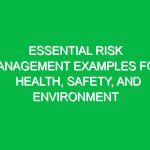Welcome to Our Toolbox Talk
Good morning, team! Today, we’re going to dive into an essential topic that affects each of us in our daily work: Incident Report Writing: A Comprehensive Guide. Understanding how to write effective incident reports is crucial in our Health, Safety, and Environment (HSE) practices. So, let’s get started!
Why Incident Report Writing Matters
Every workplace faces potential Hazards, and incidents can occur despite our best efforts. Whether it’s a near miss, an injury, or any other type of incident, documenting these occurrences through incident reports is vital. Why? Because these reports help us:
- Identify trends: Understanding the patterns in incidents can help us address underlying issues.
- Improve Safety practices: By analyzing reports, we can refine our Safety protocols and Training.
- Comply with Regulations: Proper documentation is often a legal requirement and helps us stay compliant.
- Enhance communication: Reports serve as a communication tool among team members and management.
In essence, effective incident report writing not only helps in preventing future incidents but also fosters a culture of safety within our organization.
Key Components of Incident Reports
To master Incident Report Writing: A Comprehensive Guide, it’s essential to understand the key components that make up a thorough incident report. Let’s break these down:
1. Basic Information
Every incident report should start with basic details:
- Date and time: When did the incident occur?
- Location: Where did the incident take place?
- People involved: Names and roles of those directly involved in the incident.
2. Description of the Incident
Provide a clear and concise description of what happened. Focus on:
- The sequence of events leading up to the incident.
- The actions taken during the incident.
- The aftermath and any immediate response.
Be objective and avoid inserting personal opinions; stick to the facts.
3. Causes and Contributing Factors
Analyze what led to the incident. Consider:
- Were there any safety protocol failures?
- Were environmental conditions a factor?
- Was there a lack of training or equipment?
Identifying these elements is key to preventing future incidents.
4. Recommendations for Future Prevention
After documenting the incident, suggest measures to prevent similar occurrences in the future. This could include:
- Additional training for staff.
- Changes to equipment or processes.
- Regular safety audits.
5. Follow-Up Actions
Document any follow-up actions taken after the incident, such as:
- Medical treatment provided.
- Investigations conducted.
- Meetings held to discuss the incident.
Real-Life Example: A Scenario
Let’s consider a hypothetical scenario to illustrate the importance of writing an effective incident report. Imagine a worker slips and falls in a wet area of the facility. Here’s how the incident report might look:
Basic Information
- Date and Time: March 15, 2023, 10:30 AM
- Location: Warehouse Section B
- People Involved: John Doe, Warehouse Worker
Description of the Incident
John was walking through Warehouse Section B when he slipped on a wet floor that had not been marked with a caution sign. He fell and landed on his left side, sustaining minor bruises.
Causes and Contributing Factors
- The wet floor was due to a spill that was not cleaned up promptly.
- No caution signs were placed to alert other workers.
Recommendations for Future Prevention
- Implement a system for immediate clean-up of spills.
- Ensure that caution signs are readily available and used in case of spills.
Follow-Up Actions
- John received first aid treatment for his bruises.
- A safety meeting was held to review proper spill management protocols.
This example highlights how a clear and concise report can help address the situation and prevent future incidents.
Best Practices for Incident Report Writing
Now that we have a grasp of the components, let’s discuss some Best Practices to keep in mind when writing incident reports:
1. Be Timely
Complete the report as soon as possible after the incident while the details are fresh in your mind. This helps ensure accuracy.
2. Use Clear Language
Avoid technical jargon that might confuse readers. Use straightforward language that everyone can understand.
3. Stick to the Facts
Focus on what happened rather than personal opinions or assumptions. This maintains the integrity of the report.
4. Review and Revise
Before submitting the report, review it for any errors or omissions. A well-edited report enhances clarity and professionalism.
Potential Hazards in Incident Reporting
While writing incident reports is vital for safety, it’s important to recognize potential hazards associated with the process:
- Confidentiality Risks: Ensure that sensitive information is handled appropriately to protect individuals’ privacy.
- Miscommunication: Poorly written reports can lead to misunderstandings and inadequate Safety Measures being implemented.
- Overreporting or Underreporting: Encourage a culture where all incidents are reported accurately without fear of repercussions.
Regulations and Standards
Familiarize yourself with relevant regulations and company policies regarding incident reporting. This ensures that our practices align with legal obligations and industry standards. Compliance impacts not only our safety but also our legal standing as an organization.
Engaging the Team
Now, I want to open the floor for discussion. Can anyone share an experience where effective incident reporting made a difference in your work environment? What challenges have you faced in writing or submitting reports?
Your feedback is crucial as it helps us learn from each other and improve our safety practices.
Conclusion
In conclusion, mastering Incident Report Writing: A Comprehensive Guide is essential for maintaining a safe workplace. By documenting incidents clearly and accurately, we can foster a culture of transparency and continuous improvement. Thank you all for your commitment to safety and for your attention today. Let’s work together to ensure we create a safe working environment for everyone!


